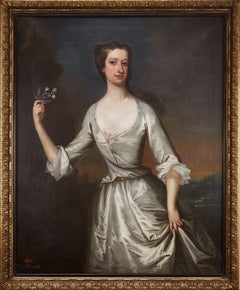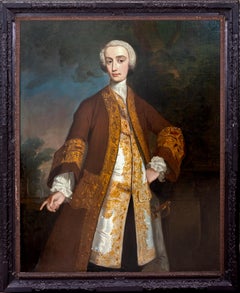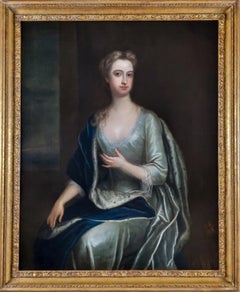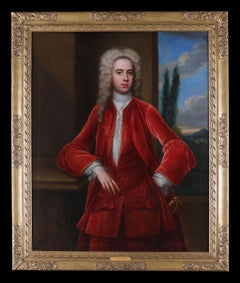Charles Jervas Art
Irish, 1670-1739
Charles Jervas was born in Dublin in 1675 who later lived in England. After moving to England, Jervas became an apprentice to the painter Sir Godfrey Kneller. He later studied drawing in Rome and then returned (c. 1709) to England. Succeeding Kneller, he became court painter to the English kings George I and George II. His home became a centre for literary figures, among them Alexander Pope and Jonathan Swift, whose portraits Jervas painted, in addition to that of George II (1728). He produced a translation of Miguel de Cervantes’s Don Quixote (published posthumously, with his surname spelled Jarvis, in 1742).to
1
2
2
2
1
1
English 18th century portrait of Henrietta Pelham-Holles, Duchess of Newcastle.
By Charles Jervas
Located in Bath, Somerset
Portrait of Henrietta Pelham-Holles (née Godolphin) (1701-1776), Duchess of Newcastle, standing in a wooded landscape with a river beyond, three-quarter length wearing an ivory silk ...
Category
1720s Old Masters Charles Jervas Art
Materials
Canvas, Oil
Portrait Of 1st Baron Hawkstone, Sir Rowland Hill, Tory MP for Lichfield
By Charles Jervas
Located in Blackwater, GB
Portrait Of 1st Baron Hawkstone, Sir Rowland Hill, Tory MP for Lichfield (1705-1783)
by Charles JERVAS (1675-1739)
Large 18th Century portrait of Baron Hawkstone, Sir Rowland Hill,...
Category
18th Century Charles Jervas Art
Materials
Canvas, Oil
$11,073 Sale Price
25% Off
Related Items
10-11-9 - 21st Century, Contemporary, Nude Painting, Oil on Canvas
By Montse Valdés
Located in Barcelona, Catalonia
“I paint the human figure and explore further till I reach the Beauty of Being, the Soul.. the part of Human Being where everything is in total Serenity, Goodness and Harmony, where ...
Category
21st Century and Contemporary Contemporary Charles Jervas Art
Materials
Canvas, Oil
$17,477 Sale Price
20% Off
H 51.19 in W 76.78 in
Italian 18th Century Oval Religious Oil on Canvas Painting with Saint Dominic
By Francesco de Mura
Located in Firenze, IT
This beautiful Italian 18th Century old masters oil painting on oval canvas with giltwood frame is attributed to Solimena and features a religious scene.
In this splendid oval-shaped painting are depicted Saint Dominic...
Category
18th Century Old Masters Charles Jervas Art
Materials
Canvas, Oil
$12,980
H 21.66 in Dm 15.75 in
Male and female portrait, both in silk kimono, possibly textile dealers
By Christoffel Lubieniecki
Located in Amsterdam, NL
CHRISTOFFEL LUBIENIECKI (1659-1729)
Pair of portraits of a gentleman and a lady, both in silk kimono, before a country house (circa 1680)
Indistinctly signed “C.......” on a box under the man’s left hand
Oil on canvas, 79.5 x 67 cm each
Both sitters are portrayed wearing a silk “Japanese” coat. During the second half of the seventeenth the Japanese silk coat, an adapted Japanese kimono, became a real vogue in the Dutch elite. The exclusive Dutch trade contacts with Japan can explain the popularity of the kimono-style silk coats in the Netherlands. Everybody who could afford one, dressed in such a fashionable and comfortable coat and, like the present sitters, some proud owners had themselves portrayed in a “Japanese” coat often together with an oriental carpet to underline their standing and international connections. These portraits are the work of the Polish-born portraitist Christoffel Lubieniecki (also known as Lubienitski, Lubinitski or Lubiniecki)
Lubieniecki was first trained in Hamburg under Julian Stuhr and after 1675 in Amsterdam under Adriaen Backer and Gerard de Lairesse. He specialized in landscapes, generally of an Italianate character, and in portraits. The loving execution of these contented burghers, enjoying the garden vistas of their country house, places him alongside Amsterdam portraitists such as Constantijn Netscher and Michiel van Musscher...
Category
1680s Old Masters Charles Jervas Art
Materials
Canvas, Oil
$37,762
H 31.34 in W 26.38 in D 1.97 in
Early 20th century Art Deco Male nude oil painting of Narcissus
By George Frederick Hinchcliff
Located in Harkstead, GB
An incredibly striking study of the male form with the figure set against a colourful background with stylised organic forms. Attractively framed, the painting is ready to be hung an...
Category
1930s Modern Charles Jervas Art
Materials
Oil, Canvas
$1,556 Sale Price
29% Off
H 16 in W 20 in D 2 in
Portrait of a Gentleman, David Erskine, 13th Laird of Dun, Wearing Armour c.1700
Located in London, GB
The gentleman in this exquisite oil on canvas portrait, presented by Titan Fine Art, is shown with the grandiloquence characteristic of the English School of painting. He is portray...
Category
17th Century Old Masters Charles Jervas Art
Materials
Oil, Canvas
$7,986
H 35.44 in W 30.71 in D 2.37 in
19th Century By Giuseppe Molteni Portrait of a Woman Oil on Canvas
Located in Milano, Lombardia
Giuseppe Molteni (Affori (Milano), Italy, 1800 - Milano, Italy, 1867)
Title: Portrait of a Woman
Medium: Oil on canvas
Dimensions: without frame 67 × 55 cm - with frame 91.5 x 80 cm
...
Category
19th Century Old Masters Charles Jervas Art
Materials
Oil, Canvas
$26,150 Sale Price
20% Off
H 26.38 in W 21.66 in D 1.97 in
18th c. French Portrait of a Lady as Venus, attributed to Pierre Gobert
By Pierre Gobert
Located in PARIS, FR
Portrait of a Lady as Venus
ATTRIBUTED TO PIERRE GOBERT (1662-1744)
FRENCH SCHOOL AROUND 1720
OIL ON CANVAS: H. 55.51 in, W. 42.91 in.
IMPORTANT 18TH CENTURY GILTWOOD FRAME (RE-GILT)...
Category
Early 18th Century Old Masters Charles Jervas Art
Materials
Canvas, Oil
$32,098 Sale Price
20% Off
H 68.9 in W 55.91 in
18th Century Circle of Jean-Étienne Liotard Portrait of a lady Oil on canvas
Located in Milano, Lombardia
Circle of Jean-Étienne Liotard (Geneva, Switzerland, 1702 – 1789)
Portrait of a lady
Medium: Oil on canvas
Dimensions: without frame 73 x 58 cm – with frame 87.8 x 73.7 x 4.5 cm
Not ...
Category
18th Century Old Masters Charles Jervas Art
Materials
Canvas, Oil
$31,531 Sale Price
20% Off
H 28.75 in W 22.84 in
19th Century by Sir Henry Raeburn Portrait of a landowner Oil on canvas
By Sir Henry Raeburn
Located in Milano, Lombardia
Sir Henry Raeburn (Stockbridge, Edinburgh, UK, 1756 - Edinburgh, UK, 1823)
Title: Portrait of a landowner
Year: Early 19th century, 1803
Medium: Oil on canvas
Dimensions: Without fra...
Category
Early 19th Century Old Masters Charles Jervas Art
Materials
Oil, Canvas
$36,724 Sale Price
20% Off
H 63.78 in W 51.46 in D 1.58 in
Venice Landscape Italian Oil on Canvas Painting in Gilt Wood Frame, Belle Epoque
Located in Firenze, IT
This delightful turn of the century (early 20th century) oil on canvas painting represents an Italian landscape with one of the most famous squares in the world: Piazza San Marco in ...
Category
Early 20th Century Impressionist Charles Jervas Art
Materials
Canvas, Oil
Venice Landscape Italian Oil on Canvas Painting in Gilt Wood Frame, Belle Epoque, Early 20th Century
$8,408 Sale Price
25% Off
H 51.19 in W 33.47 in D 1.19 in
17th Century by Andrea Vaccaro Penitent Magdalene Oil on canvas
Located in Milano, Lombardia
Andrea Vaccaro (Naples, Italy, 1604 – 1670)
Title: Penitent Magdalene
Year: 1630-1635 ca.
Medium: Oil on canvas
Dimensions: without frame 75 x 62 cm – with frame 87.5 x 74.7 x 5.5 cm...
Category
17th Century Old Masters Charles Jervas Art
Materials
Canvas, Oil
$55,605 Sale Price
20% Off
H 29.53 in W 24.41 in
18th Century by Alessandro Longhi Portrait of a young musician Oil on canvas
Located in Milano, Lombardia
Alessandro Longhi (Venice, Italy, 1733 – 1813)
Title: Portrait of a young musician in front of his desk with a score in his hand
Medium: Oil on canvas
Dimensions: without frame 39.5 ...
Category
18th Century Old Masters Charles Jervas Art
Materials
Canvas, Oil
$13,641 Sale Price
20% Off
H 15.56 in W 12.8 in
Previously Available Items
Portrait of Frances, Viscountess Scudamore in a Silver Dress & Blue Cloak
By Charles Jervas
Located in London, GB
Portrait of Frances, Viscountess Scudamore in a Silver Dress and Blue Cloak c.1709-1719
By Charles Jervas (1675-1739)
This elegant and graceful portrait, presented by Titan Fine Ar...
Category
18th Century Old Masters Charles Jervas Art
Materials
Canvas, Oil
Charles JervasPortrait of Frances, Viscountess Scudamore in a Silver Dress & Blue Cloak, c.1709-1719
H 58.27 in W 48.04 in D 3.15 in
Portrait of a Man possibly Arthur Viscount Irwin, Temple Newsam Oil on canvas
By Charles Jervas
Located in St. Albans, GB
Charles Jervas
Possibly Arthur, 6th Viscount Irwin (Temple Newsam)
Oil on Canvas
Picture Size: 50 x 40"
Outside Frame Size: 58 x 48"
1675 – 1739
Charles Jervas, who was born in Cl...
Category
Early 1700s English School Charles Jervas Art
Materials
Oil
Portrait of a Lady possibly Frances Thynne, Lady Worsley 1673-1750 Oil on canvas
By Charles Jervas
Located in St. Albans, GB
Charles Jervas
Possibly Frances Thynne, Lady Worsley 1673-1750
Oil on Canvas
Picture Size: 50 x 40"
Outside Frame Size: 58 x 48"
1675 – 1739
Charles Jervas, who was born in Clonli...
Category
Early 1700s English School Charles Jervas Art
Materials
Oil
Portrait of Hannah Clements as a Shepherdess c.1730; by Charles Jervas
By Charles Jervas
Located in London, GB
This elegant and graceful portrait is said to represent Hannah Clements (1710-1781) nee Gore. Painted by Charles Jervas - who was in 1723 appointed to the post of King’s Painter by George I and in 1725 to George II - it is one of his finest and most impressive examples. Jervas was considered the supreme practitioner of female portraiture in the 1720s and 1730s, and was the foremost successor to Sir Godfrey Kneller after the latter's death in 1723. Presented in an outstanding carved and gilded antique frame, a remarkable work of art in itself.
The sitter is captured in a moment of relaxation in a country landscape. Jervas continued the idiom of Sir Godfrey Kneller, his master, whilst introducing a new ease and suggestion of informality into his portraits. By depicting the sitter within the landscape with sheep Arcadian simplicity is being suggested. This draws from the tradition of pastoral literature and by the early 17th century was already popular in art; all educated individuals were familiar with Latin and Greek pastoral poetry. The mythological world of Arcady was an idyll that the ladies and gentlemen of the Court could inhabit in the guise of shepherds and shepherdesses. The pastoral tradition in literature and plays had been embraced by an aristocratic class since classical times. Life in the country was perceived as peaceful, contemplative and free of worry of hardships, a time to pursue pleasure. To be painted in such a manner created a tangible expression of power and wealth. When the portrait was painted the pastoral was so ingrained that the mere inclusion of such elements suggested Arcadia to the viewer. And this is further emphasised by painting the light to reflect sunset and the suggestion of tranquillity. Of course, the sitter did not live in such a place and this masterful painting was a flight from chaos to a tranquil world.
Hannah Catherine Clements (nee Gore) (1710-1781) was the daughter of Rev. William Gore (and granddaughter of Sir William Gore, 3rd Baronet), and Honora Prittie. She married Nathaniel Clements (1705-1777), an important Irish politician and financial figure, in January 1730. Nathaniel became the main financial manager of the British and Irish Government in Ireland during the period, and was de facto Minister for Finance from 1740 to 1777. He had an extensive property portfolio, including Abbotstown, County Dublin, estates in County Leitrim and County Cavan and was developer of property in Dublin, including part of Henrietta Street where he lived at No. 7 from 1734 to 1757 in what was described as “Parisian luxury”. The couple had six children.
Charles Jervas was born in Clonliske in Kings Country, Ireland in 1675. He received his artistic training in Kneller’s studio and was later, by the 1690’s, Kneller’s assistant. According to Vertue Jervas made small copies of the Raphael cartoons, then at Hampton Court, in about 1698 and sold them to Dr George Clarke of All Souls, Oxford who lent him £50 to embark on the then essential ‘grand tour’ in 1699. Taking in Paris and settling in Rome by 1703, he furthered his artistic training and became a voracious copyist of the old masters. George Vertue noted that he was known as “Carlo Jervasi” and was a “good, engenious painter”. On his return to London in 1709 Tatler (15th April 1709) remarked that he was 'the last great painter Italy has sent us' and noted that he “painted many ladies as shepherdesses and country girls”. The style that he cultivated made him Kneller's natural successor when that artist died in 1723.
In 1727 he married a widow, Penelope Hume, a lady of considerable means (£20,000). In September 1738 he travelled to Italy seeking some reprieve from his asthma, returning in May 1739. He died in November that year and bequeathed £1000 to his friend, Pope, should he outlive his widow: this did not happen as she survived until 1747. The following spring his considerable art collection was sold in 2265 lots in a sale lasting 9 days.
Apart from royalty Jervas gained the patronage of many of the ruling and intellectual elite. He moved in the highest circles of the literary and social world and became an intimate of Sir Robert Walpole and the poet Alexander Pope, to whom he gave drawing lessons.
Jervas’ portrait of Elizabeth Felton, of Playford, Later Countess of Bristol (1677-1741) realised £45,410 at Christies London 11th June 2002, lot 13. His portrait of Lady Barbara North realised £42,050 at Christies London 11th July 2008, lot 55.
Titan Fine Art are pleased to offer this work, which is representative of the artist’s best work.
Provenance: Private collection, Beal House...
Category
18th Century Old Masters Charles Jervas Art
Materials
Canvas, Oil
H 60.24 in W 50.4 in D 3.15 in
English 18th century portrait of Henrietta Pelham-Holles, Duchess of Newcastle.
By Charles Jervas
Located in Bath, Somerset
Portrait of Henrietta Pelham-Holles (née Godolphin) (1701-1776), Duchess of Newcastle, standing in a wooded landscape with a river beyond, three-q...
Category
1720s Old Masters Charles Jervas Art
Materials
Canvas, Oil
Portrait of William Townshend
By Charles Jervas
Located in Bath, Somerset
Attributed to Charles Jervas (Ireland 1675-1739 London) Portrait of William Townshend (1702-1738), three- quarter length, standing in a landscape wearing a red velvet coat...
Category
18th Century and Earlier Old Masters Charles Jervas Art
Materials
Oil
Charles Jervas art for sale on 1stDibs.
Find a wide variety of authentic Charles Jervas art available for sale on 1stDibs. You can also browse by medium to find art by Charles Jervas in canvas, fabric, oil paint and more. Much of the original work by this artist or collective was created during the 18th century and is mostly associated with the Old Masters style. Not every interior allows for large Charles Jervas art, so small editions measuring 41 inches across are available. Customers who are interested in this artist might also find the work of Studio of Sir Peter Lely, Flemish School, 17th Century, and Sir Godfrey Kneller. Charles Jervas art prices can differ depending upon medium, time period and other attributes. On 1stDibs, the price for these items starts at $19,172 and tops out at $19,172, while the average work can sell for $19,172.



